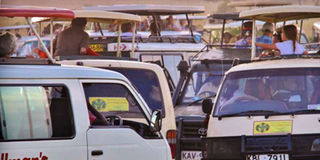Out in the Mara for the beautiful gala

Game watching at the Maasai Mara. PHOTO| JOHN FOX
What you need to know:
Clearly, there are some accommodation planning and vehicle control issues to be resolved for what must be Kenya’s main tourist attraction — or the Narok County Council will risk the loss of their goose that is laying its golden eggs.
Also, the last 70-odd kilometres of unpaved and corrugated road to the main Sekanani Gate of the Mara make for a bone-shaking and car-breaking ordeal.
But, once inside the National Reserve, you would be very unlucky not to feel that the rough journey was worth it.
Andreas, our son, is a stickler for bush etiquette. Driving us in the Masai Mara the other day, he stopped the vehicle to pick up a discarded plastic bag. But when he held it up he discovered that it had urine in it and had been used as a flying toilet. Perhaps whoever did it was too afraid of what he might find behind an otherwise convenient bush.
Litter is not a big problem in the Mara; yes, you do see a few plastic bottles and such thrown out by the roadside, especially near the camps and lodges. But it is not nearly as big a problem as the uncontrolled number of tourists and their vehicles.
For example, we came across a pride of lions on a rocky outcrop — three adult females and six young cubs. But they were well outnumbered by the more than 20 watching vehicles, with their passengers leaning out of the roof hatches and clicking away with their cameras.
When one of the female lions decided to come down from the rocks to cross the road to their wildebeest kill, she confidently walked between the minibuses – obviously she was used to such a scenario. But the cub that tried to follow her was quite nonplussed. He stopped, paused, and went back to the rocks.
Clearly, there are some accommodation planning and vehicle control issues to be resolved for what must be Kenya’s main tourist attraction — or the Narok County Council will risk the loss of their goose that is laying its golden eggs.
Also, the last 70-odd kilometres of unpaved and corrugated road to the main Sekanani Gate of the Mara make for a bone-shaking and car-breaking ordeal. But, once inside the National Reserve, you would be very unlucky not to feel that the rough journey was worth it.
And we were certainly lucky in what we saw. The wildebeest and zebra migration could well be counted among a contemporary listing of the new Seven Wonders of the World. From each July, over a million animals move from the Serengeti in Tanzania to the Masai Mara — and they move back in October. It’s all about following the rains, and the grass really being greener on the other side.
So one of the highlights of our own couple of days in the Mara was seeing hundreds of wildebeest make a river crossing. We could see them bunching on the Tanzania side of the Sand River. When the pressure of numbers built to breaking point, one brave individual charged down the bank and crossed the shallow waters. And the hundreds followed in a rushed single file.
Both days, as we drove across the Mara we could see wildebeest in their many thousands, dotted on the sloping plains like currants embedded thickly on massive Easter buns. The Mara predators must be enjoying a very easy buffet time.
On an early morning drive, Andreas noticed a giraffe was standing alert and looking intently at something in the distance. We followed his direction of gaze with our binoculars and spotted the silhouette of a cheetah on a bushy ridge. When we returned to the same area in the evening, we discovered that the cheetah was the tourist-friendly Malaika. She was with three of her almost fully grown offspring. They must have been very well-fed because, when they saw us, they gave up their pestering of a lone wildebeest and, curiously, they came right up to our vehicle.
My daughter and her family were with us. Catherine was first in the Mara in 1969, when she was only six months old and travelling with us in a carry cot on the back seat of the car. We had stayed in the Keekorok Lodge. So, for sentimental reasons, we chose the lodge again. It proved to be a very good choice. It is strategically well-placed for driving out to good game-viewing areas. And, since it is not fenced, some animals also come close to view us humans.
We could see the herds of wildebeest and zebra from our banda — because the bandas and cottages are spaced out across broad lawns with their yellow-barked fever trees. And the lodge has an excellent boardwalk across pools where hippos wallow and grunt.
At the end of the boardwalk there is a bar, from where you can drink at ease as you watch and listen.
At Keekorok this time you wouldn’t think that Kenya’s tourist trade was in any kind of trouble. The lodge was full. The visitors were from all over the world, but at least half of them were from China. The lodge was catering for them well. There were guidebooks displayed in Chinese. And the chef knows enough Chinese to ask such things as whether the eggs should be fried or in an omelette.
There was a happy buzz about the place. Good for us and good for Kenya — but out there on the Mara plains there are still some overcrowding problems to be solved.
The writer is managing director, iDC





